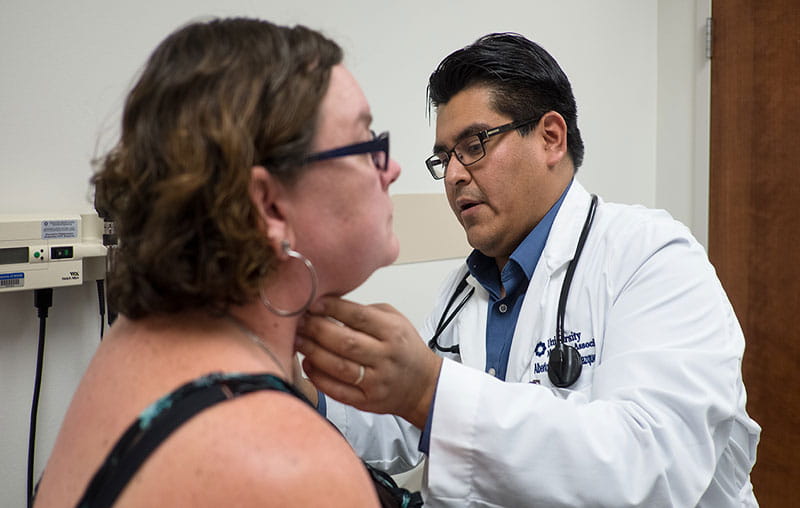Obesity is a big problem in San Antonio. It’s especially a problem in the 78207 ZIP code, where Dr. Saima Siddiqui practices at the Robert B. Green campus.
“Because we deal with the underserved patient population in our downtown location, almost 95% of our patients are obese,” Siddiqui said.
Mindful Choices Clinic
Within the Robert B. Green campus is the Mindful Choices clinic, which serves obese patients before and after weight loss surgery. Since the clinic opened in 2019, it has served over 1,000 obese patients.
A 2017 report from the City of San Antonio reported that 71% of adults in San Antonio are overweight or obese. That’s just under 1 million people.
Your body mass index, which is calculated using your height and weight, determines if you are obese or overweight. A BMI of 30 or more indicates obesity. Calculate your BMI using our calculator.
Multiple Factors Contribute to Obesity in San Antonio
A common misconception is that unhealthy eating is solely to blame for obesity. While inaccessibility to healthy food is a contributing factor, Siddiqui says blaming obesity on one single factor is not seeing the full scope of the problem.
“All healthy food, no matter what it is, is expensive. But in my opinion, that is a very simplistic view toward obesity,” Siddiqui said. “Obesity is a multifactorial thing.”
Siddiqui said obesity can also be caused by a combination of:
- A busy lifestyle, where picking up fast food is easier
- A lack of education about healthy living
- A sedentary lifestyle and too much screen time
- Financial stress
- Psychological or emotional distress, and using food as a coping mechanism
- Side effects from medications that cause weight gain
The 78207 ZIP code, where the Robert B. Green campus is located, is one of San Antonio’s lowest-income areas. Siddiqui said many of her patients are living below the poverty level and more likely to experience the problems listed above.
A 2019 analysis of census data found that four San Antonio ZIP codes had the worst rates of poverty, unemployment, lack of health insurance and lack of education in the city. These ZIP codes were 78202, 78207, 78208 and 78211.
Health Complications of Obesity
Obesity can lead to serious health complications if it is not treated. The most common complications of obesity in adults are:
- Depression
- Heart disease
- High blood pressure
- Joint problems/arthritis
- Sleep apnea
- Type 2 diabetes
Children who are obese can also experience health complications that are usually only seen in adults. Siddiqui said about 5% of her obese patients are children.
“We see a lot of obese kids, unfortunately,” Siddiqui said. “We are seeing a lot of diabetes, high blood pressure and cholesterol problems in these young kids due to unhealthy eating, sitting and watching TV, and playing video games.”
Climate Change Affects Access to Healthy Food
An integral part of fighting obesity is eating a healthy diet. As Siddiqui said, it is not a cure for obesity, but it helps. However, fresh, affordable fruits and vegetables might become harder to find in the future. As we experience more hot-weather days and less rainfall, farmers will have a harder time growing fruits and vegetables.
Plus, extreme weather events like floods and snowstorms can wipe out crops in an instant. And if roads are blocked after storms, trucks can’t deliver food to grocery stores.
In Texas, there was a rush on grocery stores like H-E-B during the February 2021 snowstorm that caused widespread utility failures. Panicked, people across Texas loaded up their carts with whatever they could find and produce, meat and dairy sections remained empty for days. Delivery trucks carrying food could not navigate the icy roads. This extreme weather event directly impacted grocery stores’ ability to keep essentials stocked for everyone.
With climate change continuing to cause events like the 2021 snowstorm, access to healthy food could become even more difficult for those already struggling with food insecurity.
Food Deserts in San Antonio
Without easy access to healthy foods, people turn to whatever they can find. Often, this means processed foods loaded with sugar, salt and preservatives. Some neighborhoods in the South Side of San Antonio are “food deserts”, meaning people in that area don’t have easy access to grocery stores that offer healthy options like fresh fruits and vegetables.
People who live in food deserts are more likely to develop:
- Chronic diseases
- Heart disease
- Obesity
- Type 2 diabetes
“Food deserts are a real problem, and I hope that our society can do something about that,” Siddiqui said. “But here in San Antonio, obesity is not because of food deserts. Obesity is because of lack of knowledge, going for refined carbohydrates, and less physical activity. These are the major causes of obesity.”
A 2019 report from Texas Appleseed, an advocacy group, found a clear correlation between low-income areas and poor health. “Areas with the highest obesity rates in San Antonio largely mirror those with high smoking rates and lower incomes,” the report states. “The same holds true for other chronic diseases and unhealthy behaviors, including high blood pressure, diabetes and physical inactivity.”
Fighting Obesity in San Antonio
Recently, San Antonio has made progress in fighting obesity in children and adults. From 2013 to 2014, the percentage of obese adults dropped from 35% to 32%.
The CDC awarded San Antonio funds to create programs promoting healthy living, like:
- Síclovía
- Bike-share program
- ¡Por Vida! restaurant recognition program
- Providing 361 schools with the resources to expand physical education
Additionally, the Mayor’s Fitness Council partnered with Michelle Obama’s Let’s Move! Initiative. Through this program, the city funded salad bars in elementary, middle and high schools. This helps make fresh options readily available to kids and teens.
For people who live in food deserts, the City of San Antonio Office of Sustainability offers programs to find healthy food options, including:
- San Antonio Farmers Markets
- San Antonio Food Bank Mobile Mercado, a mobile grocery store offering affordable healthy options that visits the Mindful Choices clinic each Tuesday
- San Antonio Area Garden’s Map
How to Fight Childhood Obesity in South Texas
Often, obesity starts in childhood. It can be harder to lose weight without starting healthy habits from a young age. A 2017 study of children in South Texas found that 23% of kids ages 2-17 are obese.
Use our BMI calculator for children and teens.
Creating healthy habits for your kids starts at home, and it doesn’t have to be hard. Here are some easy tips to incorporate into your day:
- Be a good role model and eat well
- Don’t keep sugary drinks (soda, fruit juice) in the house
- Never use food as a reward (and don’t withhold food as a punishment)
- Put a limit on screen time
- Serve fruit or vegetables at each meal
- Siddiqui says frozen fruits, vegetables, and meat are healthy substitutes when you can’t find fresh ingredients
- Take your children grocery shopping and help them make good choices
- When possible, get your children to play outside

Heart disease is the leading cause of death for both men and women.
Our free online risk assessment only takes a few minutes. It will help you better understand your risk of developing heart disease and how you may be able to lower it.





